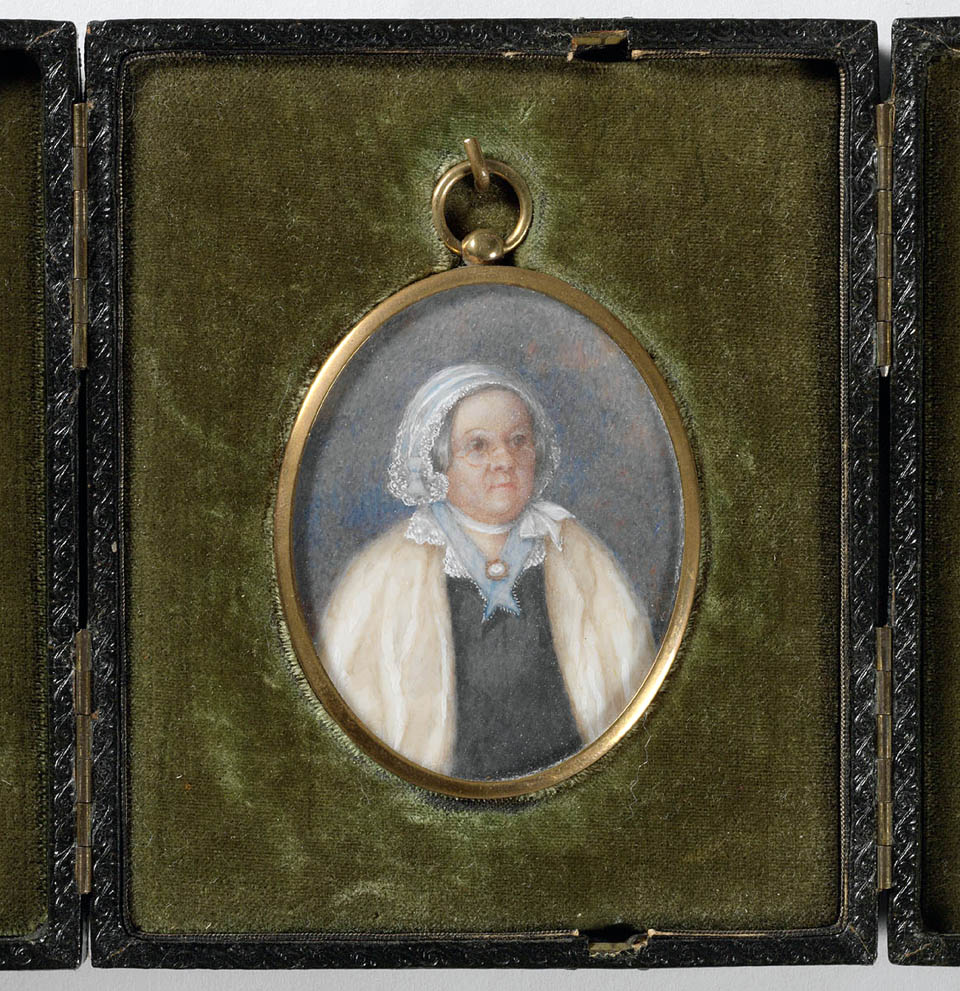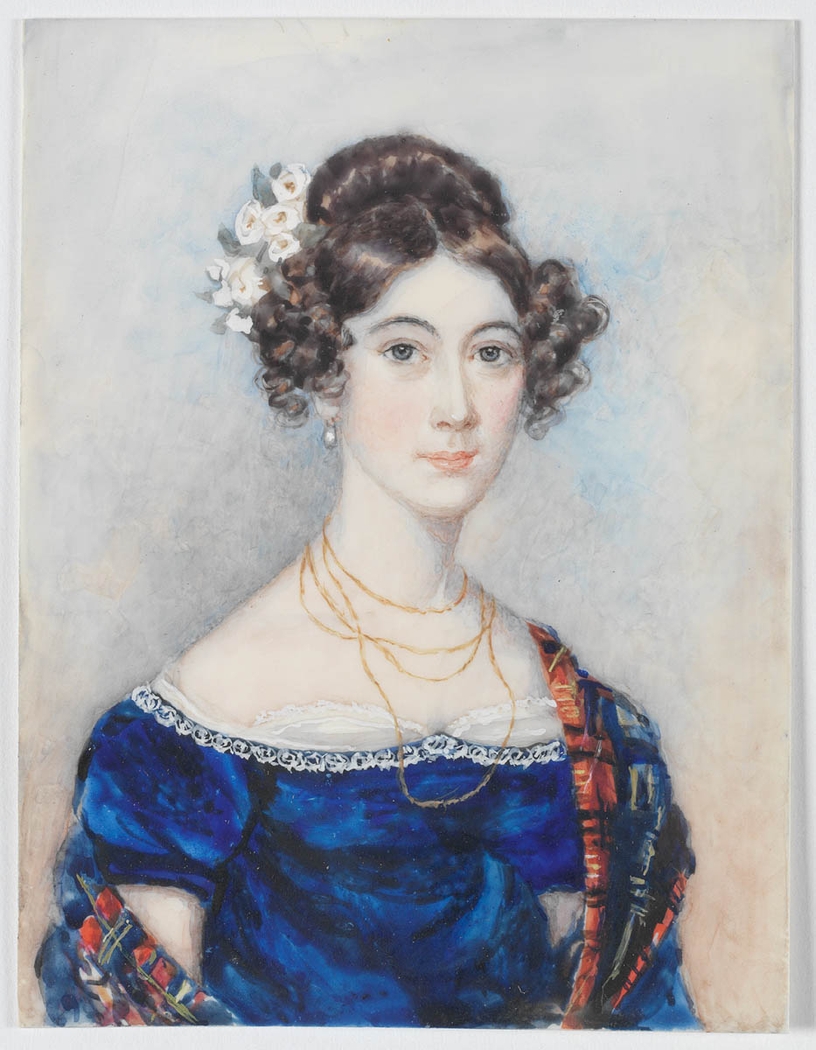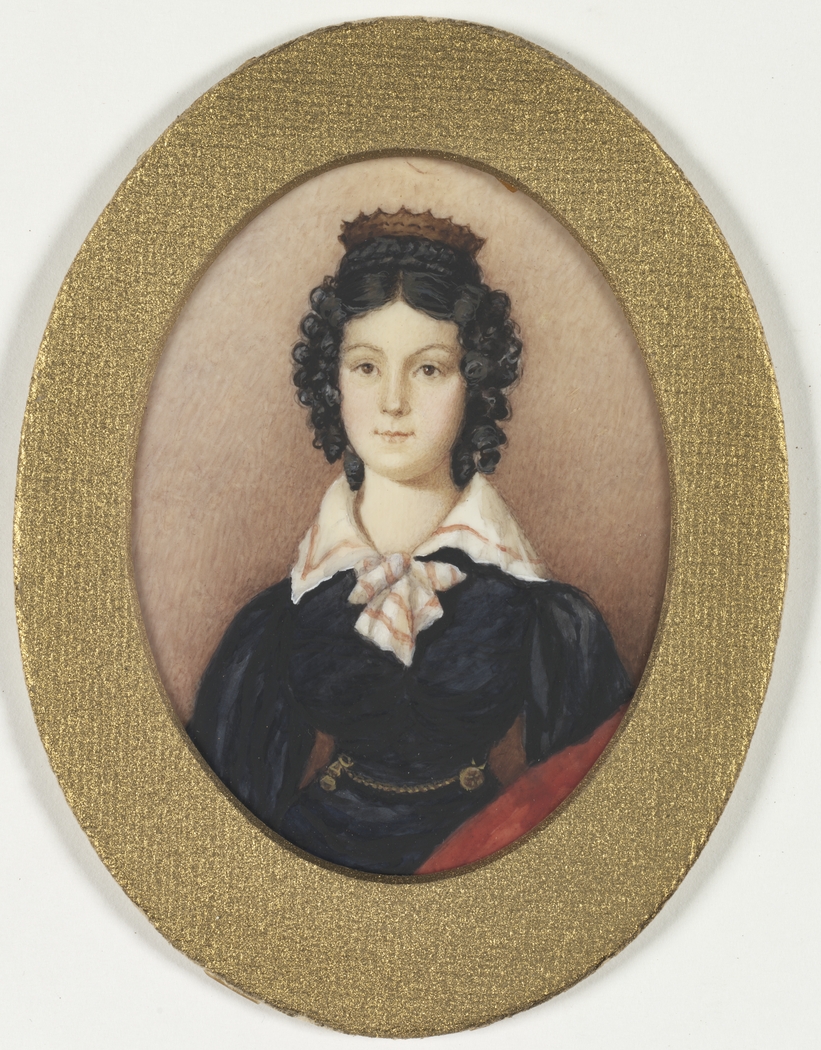The Dictionary of Sydney was archived in 2021.
Mary Reibey
Citation
Persistent URL for this entry
To cite this entry in text
To cite this entry in a Wikipedia footnote citation
To cite this entry as a Wikipedia External link
Mary Reibey
[media]Mary Reibey, whose name is spelled variously Reiby, Rabey and Reibey, arrived in Sydney in 1791 as a teenaged convicted horse thief and, through a fortuitous marriage and her own business acumen, became a leading colonial entrepreneur and philanthropist.
Early life
[media]Mary Reibey was born Molly Haydock on 12 May 1777 in Bury, Lancashire, England. [1] Her parents were respectable members of middling yeomanry status, however she was orphaned at an early age and was brought up by her maternal grandmother. Mary was well educated at Blackburn Grammar School and attended church regularly. On the death of her grandmother in 1790 she left Lancashire and in 1791, aged just 14 years, she was arrested for the serious crime of horse stealing. [2] When arrested she was dressed as a boy and identified herself as James Burrows, after a boy she knew who had recently died. Mary managed to maintain her disguise as a boy but was unmasked at her trial at Stafford Assizes. Horse stealing was punishable by death in the late eighteenth century but Mary was spared the hangman's noose on account of her 'tender age' and was sentenced to seven years' transportation. She arrived in New South Wales on Royal Admiral in October 1792, aged 15. [3]
Marriage and respectability
On 1 September 1794, 17-year-old Mary married Thomas Reibey, a 25-year-old free settler and junior maritime officer on the East India Company store ship Britannia. It would be a fortuitous marriage for both of them and together they made 'a very solid, loyal working partnership.' [4]
Thomas was granted land on the rich and fertile Hawkesbury River and the couple established a number of productive farms and developed a cargo business along the Hawkesbury River to Sydney, which also prospered. Eventually they moved to Sydney and built a substantial stone house and trading establishment near what is now Macquarie Place and Reiby Place. They named it Entally House after the Calcutta, India suburb of Entally. Later converted to the Bank of New South Wales, this property was demolished in 1880.
By 1803 Thomas Reibey owned numerous boats and was successfully trading in coal, cedar and wheat to and from the Hunter and Hawkesbury Rivers. His ship building enterprises, so necessary for the development of the early colony, were rapidly expanding. In 1805 he was engaged in sealing in Bass Strait and by 1807 his business endeavours had expanded further afield. His schooner Mercury regularly traded with the Pacific Islands. Later he established extensive trading networks with India and China. On his many long absences, Mary kept both his family and his business interests thriving. [5]
The Reibeys had seven children; Thomas, James, George, Celia, Eliza, Jane Penelope and Elizabeth. All of the children were baptised at the old St Philip's Church, Sydney and well-educated. [6]
The death of Thomas
Thomas Reibey died in April 1811 after contracting a fatal illness on his final trading trip to Bengal. [7] Mary, with seven young children, was left with the enormous responsibility of dealing with his extensive business interests. As a wealthy widow in her early thirties she was a very eligible woman. However, Mary did not marry again. Rather, she managed both her children and business interests with admirable acumen and extended and consolidated the Reibey family empire.
In 1812 she opened a new warehouse in George Street, Sydney and the purchase of more trading vessels saw her extend her shipping and trading interests further. She secured land grants in Van Diemen's Land for her two eldest sons and began to trade extensively with interests there. By 1817, the year she turned forty, Mary Reibey was estimated to be worth £20,000, the equivalent of roughly three and a half million dollars today. Three years later she owned property and land totalling a thousand acres. [8]
Triumphal return home
In March 1820 Mary left Sydney on the Admiral Cockburn and sailed for England with her two eldest daughters Celia and Eliza. The young convicted horse thief had transformed into a wealthy, respectable and successful colonial businesswoman. During their stay they visited London, Manchester, Mary's home town of Blackburn, Liverpool, Glasgow and Edinburgh. Mary kept a diary of the trip which today reads as a whirlwind of socialising, shopping and visiting old friends and acquaintances. They often went to the theatre and attended many society balls and parties. It seems that Mary and her daughters were partial to elaborate dinners, drinking wine and a hand or two of whist in the evenings. She also conducted business whilst in England and met up with another successful Sydneysider of dubious parentage, William Charles Wentworth, who was in England at this time. [9]
On her return to Sydney in 1821 Mary Reibey's business affairs continued to flourish. She made extensive investments in buildings in George Street, Macquarie Place and in the Rocks. Mary was also active in the church and charitable institutions. She had a lifelong interest in education and in 1825 she was appointed a trustee of the Sydney Free Public Grammar School. [10] Mary's emancipist status did not hold her back – her stature as a successful merchant, business woman and property owner meant that she had by the 1820s, become a reputable and respectable member of colonial society. Mary took trouble to hide her convict origins, ensuring her entry in the 1828 census recorded she had arrived 'free'. [11] On her eventual retirement from business in the late 1820s she would live off the rents of her substantial property investments.
Family legacy
[media]There was tragedy in Mary's life too. As well as being widowed young, she outlived five of her own children and a number of grandchildren. Her daughter Celia married Thomas Wills in 1822 but died after the birth of a daughter in 1823, who also died the following year. A month after Celia’s death Mary's third son George was killed in an accident in Tasmania, aged just 25. Mary’s firstborn Thomas died in 1842, her second son James died in 1843 and a year before her own death in 1855 her daughter Jane Penelope also died. [12] Despite this, her children produced twenty-five grandchildren and many of them would go on to have successful lives. Mary insisted that her grandsons were educated in England. Indeed, both sons of her firstborn Thomas, Thomas and James, were educated at Eton and Oxford University and in the 1870s Thomas III would briefly serve as the Premier of Tasmania. He took the name Entally House for his splendid homestead at Hadspen, near Launceston, which has since become a National Trust property. Figtree House, on Reiby Road in Hunters Hill, was built by Mary in 1835 as her country retreat, and still stands. It is listed on the register of the National Estate. [13]
Mary's death
[media]Mary died at her extensive estate and home in Newtown on 30 May 1855 at the age of seventy-eight. Sydney had greatly changed since she had first arrived as a juvenile convict in 1792 when the colony itself was merely four years old. Mary, as a wife, mother, entrepreneur, pioneer and leading businesswoman had played a prominent role in the trajectory of the development of business and trade in colonial Australia. Her property and land extended from the Hawkesbury River to the South Coast of New South Wales and across to Tasmania. Hers was a true 'rags to riches' story which sometimes characterised the lives of convict men but less often those of convict women. The small bespectacled woman on today's $20 note was truly remarkable.
References
Catherine Bishop. Minding Her Own Business; Colonial Business Women in Sydney. Sydney: New South Press, 2015.
Kay Daniels. Convict Women. St Leonards: Allen and Unwin, 1998.
Nancy Irvine (ed). Dear Cousin: The Reibey Letters: Twenty-two letters of Mary Reibey, her children and their descendants, 1792-1901. Sydney: Janet Press, 1992.
Nancy Irvine. Mary Reibey – Molly Incognita; A Biography of Mary Reibey (1777-1855) and her World. Sydney: Library of Australian History, 2001.
Kathleen J Pullen. Mary Reibey: The Woman on the $20 Note. Sydney: Ure Smith, 1975.
GP Walsh. 'Reibey, Mary (1777–1855)'. Australian Dictionary of Biography. http://adb.anu.edu.au/biography/reibey-mary-2583/text3539.
Notes
[1] Nancy Irvine, Mary Reibey – Molly Incognita; A Biography of Mary Reibey (1777-1855) and her World (Sydney: Library of Australian History, 2001), 2
[2] Nancy Irvine, Mary Reibey – Molly Incognita; A Biography of Mary Reibey (1777-1855) and her World (Sydney: Library of Australian History, 2001), 3-11. While GP Walsh gives Reibey’s date of trial as 1790, convict muster records in State Records NSW state she was tried on 24 August 1791. GP Walsh, 'Reibey, Mary (1777–1855)', Australian Dictionary of Biography, http://adb.anu.edu.au/biography/reibey-mary-2583/text3539, viewed 21 March 2016 State Records NSW, NRS 1155, 2/8276, 134, https://www.records.nsw.gov.au/state-archives/digital-gallery/women-in-the-records/mary-reibey/images-1/1155_2_8276_p134_closeup.jpg/view, viewed 21 March 2016
[3] On board were 46 other female prisoners and 289 male convicts. Nancy Irvine, Mary Reibey – Molly Incognita; A Biography of Mary Reibey (1777-1855) and her World (Sydney: Library of Australian History, 2001), 37
[4] Nancy Irvine, Mary Reibey – Molly Incognita; A Biography of Mary Reibey (1777-1855) and her World (Sydney: Library of Australian History, 2001), 52
[5] GP Walsh, 'Reibey, Mary (1777–1855)', Australian Dictionary of Biography, http://adb.anu.edu.au/biography/reibey-mary-2583/text3539, viewed 21 March 2016
[6] Nancy Irvine, Mary Reibey – Molly Incognita; A Biography of Mary Reibey (1777-1855) and her World (Sydney: Library of Australian History, 2001), 62
[7] Sydney Gazette, 6 April 1811
[8] Catherine Bishop, Minding Her Own Business; Colonial Business Women in Sydney, (Sydney: New South, 2015), 24
[9] Nancy Irvine, Mary Reibey – Molly Incognita; A Biography of Mary Reibey (1777-1855) and her World (Sydney: Library of Australian History, 2001), 85-98
[10] Other leading colonial businessmen such as Simeon Lord and John MacArthur were also involved in this school
[11] Nancy Irvine, Mary Reibey – Molly Incognita; A Biography of Mary Reibey (1777-1855) and her World (Sydney: Library of Australian History, 2001), 136
[12] Nancy Irvine, Mary Reibey – Molly Incognita; A Biography of Mary Reibey (1777-1855) and her World (Sydney: Library of Australian History, 2001), 137
[13] A further lasting built legacy of Mary Reibey can be found at Fig Tree House, Reiby Road in Hunter's Hill, New South Wales. Mary bought land here in 1835 and built the house as her 'country' retreat. In 2010 this house was valued at over $7 million dollars and is today listed on the Register of the National Estate.
.






